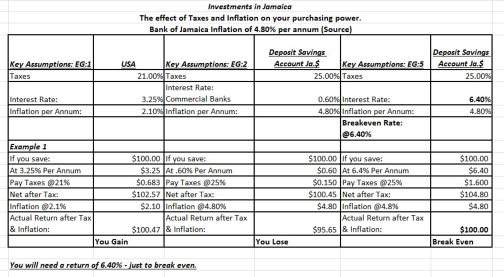The local currency deposits into the financial institutions are approximately $933 billion. Out of that amount, the leading commercial banks, National Commercial Bank and Scotiabank Jamaica Limited, account for over $500 billion.
The typical Jamaican worker lodges his/her money into a regular savings account, paying between 0.6 per cent to 1.70 per cent depending on the amount at the time of deposit and the remaining balance in the account.
Now, my question is: What is the real rate of return to the ordinary Jamaican worker? Not the nominal rate, but the real purchasing power of the funds after one year since deposit.
Equation: [+rate of return* (1 – tax rate)] – inflation rate Example: $1,000.00 deposit, rate @0.6%, inflation 4.8%, taxes 25% = $956.50; a loss in purchasing power of -$43.50 in just one year or -4.35%.
This is a major reason the average Jamaican worker is getting poorer in real terms. The banks hold deposits of approximately $500 billion, loss in purchasing power per year to the depositors is $21.75 billion, resulting in losses to ordinary Jamaicans of $418,269,230.77 per week.
With a negative rate of return you will experience less demand for goods and services; hence, lower growth in the economy.
http://www.jamaicaobserver.com/opinion/time-value-of-money-is-the-foundation-of-finance_151446




Leave A Comment